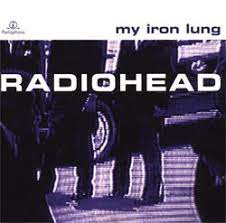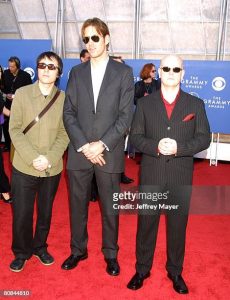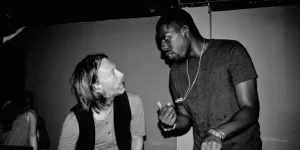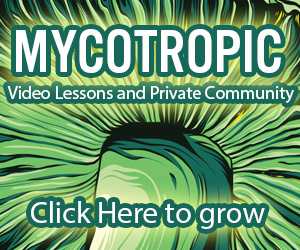Did psilocybin mushrooms play a seminal role in shaping the sound and legacy of Radiohead?
The Oxford quintet has crafted one of the most extraordinary musical careers of all time, rising from their humble roots as an unremarkable rock band in the early 90’s British scene to the peak of global super stardom while continuing to remain cryptic, wildly original, and essentially peerless throughout the process.
Around 1994, with the release of the My Iron Lung EP, they began a monumental transformation from milquetoast ‘one hit wonder’ to The Greatest Band In The World. This creative transition also coincides with the arrival of Stanley Donwood to the Radiohead camp, the importance of which I’ll outline below.

Between 1994 and 1997, Radiohead rapidly artistically evolved and started putting out music so epic that REM’s Michael Stipe was famously quoted as saying ‘Radiohead are so good it scares me’ in 1995. Something extraordinary happened in this period between 1994 and 1997, where Radiohead evolved their creative output from releases like ‘Pop Is Dead‘ (1993) to ‘Paranoid Android‘ (1997).
The band is fond of leaving ‘Easter Eggs’ in their work for fans to puzzle over and decode. I’ve been wanting to formally propose this theory for a while by piecing together clues left throughout the 30 year plus career of Radiohead, and the following is an attempt at that.
- Ed O’brien went to the Grammys on mushrooms in 2001. This is some of the most bankable evidence we have that members of the Radiohead camp are experienced with psilocybin mushrooms. Most people don’t go to a high profile awards show where they’re one of the key nominees high on mushrooms unless they know what they’re doing and have a baseline of experience with and proclivity for the effects of the psilocybin mushroom. Ed is certainly one of the most ‘diplomatic’ members of Radiohead in regards to speaking openly with the press, and so it’s probable that other members simply wouldn’t reveal or discuss their relationship with mushrooms if they indeed have one – which is very likely in my estimation. Also, what are the odds that Colin and Phil are also tripping here considering that they’re all three rocking shades on the red carpet and Ed has publicly stated that he was on mushrooms at the Grammys in 2001. It’s giving Tre Parker and Matt Stone on LSD at the Academy Awards vibes, and interestingly enough, Radiohead appeared on South Park in July 2001 – the year after Parker and Stone showed up at the biggest awards night of their industry under the influence of psychedelics. Brain food for thought.

Colin Greenwood, Ed O’Brien and Phil Selway of Radiohead (Photo by Jeffrey Mayer/WireImage)also 2. Stanley Donwood has cited ‘mushrooms and cannabis’ as being a primary influence on him and his art. It’s literally the first thing he says in this 2020 interview with Penguin Books UK, in which he states ‘I used to get a lot of mileage from magic mushrooms and cannabis.’ He follows up by saying ‘I don’t really do that anymore – I think it’s an age thing. I’d like to do magic mushrooms again, but I keep missing the vital time of year’. This last bit indicates that he’s familiar with mushroom season in England, where ‘Liberty Caps’ grow wild all over the countryside, including in the hills surrounding the University of Exeter where Donwood and Thom Yorke first met as art students.
Though not technically a Radiohead member, artist Stanley Dogwood has had a monumental influence on the Radiohead legacy as their principal album cover and accompanying art designer since 1994 – which is exactly around the time that Radiohead’s creative output first started showing signs of being noticeably ‘psychedelic’. For substantiation on this claim, simply evaluate the depth and artistry separating Pablo Honey from OK Computer.
Stanley Donwood also supposedly spent his post-college graduation years as an itinerant wanderer busking around England and ‘sleeping on people’s floors while fire breathing’. This type of young, unanchored traveling artist lifestyle certainly lends itself to psychedelic experimentation. If Donwood is bullshitting the whole interview, as he and the band have been known to do, I’d consider that even stronger evidence that the lot is experienced with psilocybin mushrooms; the ‘trickster’ or ‘jester’ archetype is strong with Radiohead, who have been known to play practical jokes on their audience and each other.
3. Thin Thing: In Thom and Jonny’s current project ‘The Smile’, the lyrics for the track ‘Thin Thing’ are appropriately cryptic while referencing mushrooms twice. The lyrics are:
On the live version of this track released on “The Smile (Live at Montreaux Jazz Festival, July 2022), Thom improvises on the second ‘mushrooms’ vocal line, pitching his voice up and heightening and drawing attention to the word with this vocal phrasing.
4. There’s powdered mushroom pigment in the paint used on the pieces for Thom Yorke and Stanley Donwood’s recent exhibition ‘The Crow Flies’. In an interview on their 2023 joint art exhibition, it’s mentioned that the paint used for the pieces by Thom and Stanley is composed of ‘gouache, tempera, and powdered mushroom’. This intentional selection, which was meritorious enough to be publicly revealed, further demonstrates that mushrooms in general have a traceable influence on Thom and the Radiohead camp.
5. Ed O’Brien has quoted Terence McKenna on multiple occasions. Ed publicly quoting Terence says a lot about the influence that the macrodose mushroom trip advocate and educator has over at least part of Radiohead. Terrence is very much a cult figure, and anyone who is publicly quoting Terrence is essentially outing themselves as having a fascination and devotion to psilocybin mushrooms.
6. Ed O’Brien definitely quoted Terence McKenna a second time around this same era in a post on Dead Air Space. I can’t find it archived anywhere, but I was in a phase of personal development strongly influenced by both Radiohead and Terence McKenna simultaneously and so seeing Ed quote Terence completely struck me. The McKenna quote, which I can’t find anywhere at the moment because I don’t have accurate phrasing, just a 15 year old recollection of a random post on the internet, stated something close to the following sentiment ‘At the end of time a single voice will echo from the heavens…‘ Again, this is definitely not the quote, but the characteristics of a single voice at the end of time / the end of history strongly resonated with me as someone who had had several of his first macrodose mushroom experiences soundtracked by Thom’s voice and Radiohead.
7. The Gloaming lyrics ‘When the walls breathe’ (x2) definitely evoke a sense of familiarity with be mushroomed consciousness. It’s a very trippy track overall, and the lyrics call to mind a sensation frequently shared by people in a mushroom induced altered state – the notion that trees / walls / objects are ‘breathing’
https://www.youtube.com/watch?v=SQ7r1I30Qh0
8. Thom has close relationships and significant collaboration with Michael Stipe and Steve Ellison (Flying Lotus), both musicians who have openly discussed psychedelics and referenced them explicitly in song titles and lyrics. This reference doesn’t expressly focus on mushrooms, but instead the connection between Thom and two significant artistic influences on him that also have a connection to Entheogens /Tryptamines.
Although Michael Stipe has publicly stated that he ‘quit all drugs in 1983’, REM is known for only focusing their PR efforts on music and not on the ‘sex and drugs’ part of rock and roll. Radiohead also largely avoids talking about anything unrelated to their music, including instances where Thom has changed the subject when pressed about the band’s drug use. Stipe’s well-documented mentorship of Thom and REM’s relationship with Radiohead in the formative years that saw Radiohead evolve into the band we know them as today certainly included advice on how to talk to the press and how to present publicly while in the spotlight.

The lyrics for the REM song Be Mine include:” I’ll eat the lotus and peyote…” Thom Yorke has actually covered this song with REM as his backing band, though the full version unfortunately doesn’t appear to be publicly available anywhere. REM guitarist Mike Mills is quoted at the beginning of the video saying that it was Thom’s choice to sing Be Mine, ‘which is an interesting choice…’ the tone in which he says this, coupled with other remarks from the sound clip, suggest that Be Mine is not a typical song from their repertoire that the band was expecting Thom to select for their joint performance. Thom has discussed listening to REM heavily during his college years at the University of Exeter, where Stanley Donwood was a friend of his prior to their formal professional collaboration. Am I reading way too far into this, or were Thom and Stanley listening to REM and tripping on mushrooms or other psychedelics at some point while in college – and perhaps after?
Here’s a link to the video of the session, which inexplicably cuts off halfway through:
https://www.youtube.com/watch?v=eKPg1rURPqo
Thom’s relationship and reciprocal influence with Flying Lotus is also extremely well-documented. Fly Lo has openly publicly discussed how DMT experiences have shaped his sound and creative output, an influence which feels heavily ingrained in his music. Fly Lo’s record label is called Brainfeeder and his whole persona and artistic legacy is saturated with psychedelic influence. For Thom to be so deeply invested in the work of Flying Lotus and to collaborate several times with him while also bringing him on tour with both Atoms For Peace and Radiohead represents another ‘one degree of separation’ between Tryptamines and Radiohead.
In fact, Flying Lotus is quoted as saying the first time he smoked DMT, he journeyed to ‘Pyramid Song’ by Radiohead. Here’s Fly Lo describing his first DMT experience:
“…An amazing roller coaster of images, patterns, and geometry. It seemed at one point I felt the presence of beings communicating with me, in the same way I’d feel it in sleep paralysis states. I asked, ‘what are you saying?’. ‘What are you trying to tell me?’. It was all moving so fast, too fast to grasp. Any worries or fears that I had about anything would quickly be replaced with overwhelming feelings of love and warmth. It felt like the universe hugged me and held me tight. Despite the chaos, there was nothing to fear, this is a place of loving energy. The curtain pulled back slowly into some kind of crazy cartoon world that was just so vibrant and wacky, colours swirling, inkblot world, crazy colour pattern world, bright colour dot world. Bugs bunny could live here…I’d get little doses of the real world, the music would come in and out, Thom Yorke’s voice and the strings of ‘Pyramid Song’ would come through brilliantly and heavily reverberated. The familiar sounds helped me come back to this plane.”
There are certainly many other potential leads and clues into the Radiohead-Mushroom connection, but the instances covered here are enough to serve as perhaps the clearest *speculative* picture yet of how mushrooms and psychedelics may have shaped the music and artistry of Radiohead.
I’d be curious to hear from people any other clues I may have missed, as well as to receive general feedback about the hypothesis proposed here. Is Radiohead influenced by mushrooms? What do you think?





